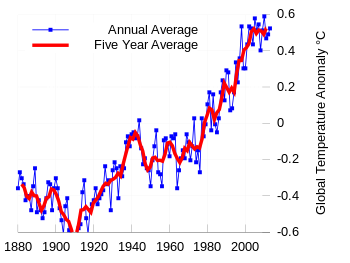 |
| Global mean surface temperature for 1880–2009 (Wikipedia) |
The Bureau of Meteorology has confirmed that 2013 was the hottest year in Australia since records began in 1910.
Unusual heat was a persistent feature throughout the year.
For the continent as a whole, we experienced our hottest day on record on January 7.
Then January was the hottest month on record, and the 2012-13 summer was the hottest recorded for the nation.
The nation-wide temperature record set for the month of September exceeded the previous record by more than a degree. This was the largest temperature anomaly for any month yet recorded.
Averaged across all of Australia, the temperature for 2013 was 1.2C above the 1961-1990 average, and well above the previous record hot year of 2005 of 1.03C above average.
What caused these extreme temperatures? Climate scientists have a problem: because climate deals with averages and trends, we can’t attribute specific records to a particular cause.
But our research has made significant headway in identifying the causes of climate events, by calculating how much various factors increase the risk of extreme climate events occurring. And we have found sobering results.
We previously analysed the role human-caused climate change played in recent extremes across Australia.
For various record-breaking 2013 Australian temperatures, we investigated the contributing factors to temperature extremes using a suite of state-of-the-art global climate models. The models simulated well the natural variability of Australian temperatures.
Using this approach, we calculated the probability of hot Australian temperatures in model experiments. These incorporated human (changes in greenhouse gases, aerosols and ozone) and natural (solar radiation changes and volcanic) factors.
We compared these probabilities to those calculated for a parallel set of experiments that include only natural factors. In this way, natural and human climate influences can be separated.
In our previous studies, we then applied an approach (known as Fraction of Attributable Risk) widely used in health and population studies to quantify the contribution of a risk factor to the occurrence of a disease.
Health studies, for example, can quantify how much smoking increases the risk of lung cancer.
Using the climate models, the Fraction of Attributable Risk (FAR) shows how much the risk of extreme temperatures increases thanks to human influences.
In our earlier study of our record hot Australian summer of 2012-13, we found that it was very likely (with 90% confidence) that human influences increased the odds of extreme summers such as 2012-13 by at least five times.
In August 2013, Australia broke the record for the hottest 12-month period. The odds of this occurring increased again from the hottest summer. We found that human influence increased the odds of setting this new record by at least 100 times.
Recent extreme temperatures are exceeding previous records by increasingly large margins. The chance of reaching these extreme temperatures from natural climate variations alone is becoming increasingly unlikely.
When we considered the 12-month record at the end of August, it was nearly impossible for this temperature extreme to occur from natural climate variations alone in these model experiments.
We have just completed a preliminary investigation of contributing factors for the record Australian temperature in the 2013 calendar year.
In the model experiments, it is impossible to reach such a temperature record due to natural climate variations alone. In climate model simulations with only natural factors, none of the nearly 13,000 model years analysed exceed the previous hottest year recorded back in 2005.

In contrast, in model simulations including both natural and human factors, such as increasing greenhouse gases, record temperatures occur approximately once in every ten years during the period 2006 to 2020.
On a mathematical note, as there is no instance in which the record hot yearly temperature occurred without human contributions, the FAR value is one.

Clearly both natural climate variability and global warming from humans contribute to recent temperature records. Natural variability always plays a major role in the occurrence of weather and climate extremes.
But in the case of our recent hottest year on record, human-caused global warming made a crucial contribution to our extreme temperatures.
Our extensive catalogue of 2013 record-breaking events in Australia occurred in a global context of increasing temperatures that must be considered. Globally, 2013 will likely rank as the 6th hottest year recorded.
So to return to our question, what caused the 2013 record hot year across Australia? Simply put, our climate has changed due to human activities. Recent extremes, such as this hot year, are occurring well outside the bounds of natural climate variations alone.
Sophie Lewis is a Research Fellow at the University of Melbourne node of the ARC Centre of Excellence for Climate System Science.
David Karoly receives funding from the Australian Research Council Centre of Excellence for Climate System Science and the Australian Antarctic Division. He is a member of the Climate Change Authority and the Wentworth Group of Concerned Scientists.
This article was originally published at The Conversation. Read the original article.

No comments:
Post a Comment